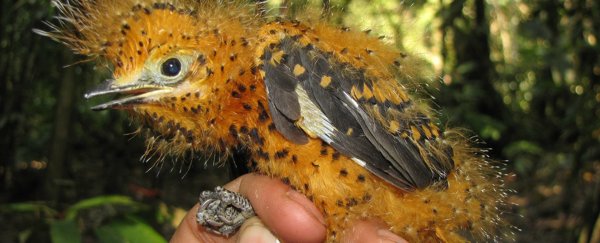You wouldn't generally think to cover yourself in fluffy orange feathers if you wanted to stay hidden, but cinerous mourner (Laniocera hypopyrra) chicks have such good camouflage game that they totally pull it off.
Living in the humid tropical forests of the Peruvian Amazon, the young cinerous mourners have come up with a fantastic strategy for staying safe while their parents are out hunting for food - they disguise themselves as big, writhing and very poisonous caterpillars, as Sandhya Sekar reports for New Scientist's Zoologger column.
This works because the baby birds are covered in spiky orange features, which are dappled with black spots and tipped with white "barbs".
But the chicks' camouflage goes beyond their striking feathers - they also display a unique behaviour from around six days old, where they put their heads down and bob them from side to side, so they look like a pulsating insect.
As you can see in the video above, the result is pretty convincing, and no predator looking to snack on young, vulnerable chicks would give the nest a second look. Their feathers also blend in with dried leaves inside their nest, so it offers them double protection.
 Santiago David-Rivera
Santiago David-Rivera
When you compare it to something like the caterpillar of the sycamore moth, it's easy to see how predators could be confused, especially as the young chicks are around 12-cm-long - roughly the same size as moth caterpillars.
Fascinatingly, these bright young things will eventually grow into extremely dull, brown birds.
But not only has this species come up with a great disguise, they're also displaying an extremely rare and unique strategy that now has scientists fascinated. Known as Batesian mimicry, this type of imitation is more common in invertebrates, where harmless butterflies will often end up with the wing-patterns of poisonous species in the area in order to be eaten.
As Sekar writes for Zoologger, the only other recorded example of the behaviour in birds is burrowing owls making hissing sounds in order to sound like a rattlesnake when they're stated.
"But in Laniocera hypopyrra's mimicry is more complex, involving both looks and behaviour, something not spotted in birds before," writes Sekar.
The behaviour was first observed by biologist Gustavo Londono, now at the University of California, who came across a cinerous mourner nest in 2012, and set up cameras to watch what was happening inside. He's now published his observations in American Naturalist.
Studying noticed that cinerous mourner parents build their nests in quite open areas, and only return to the nest once each hour while they're out foraging - this is a far lower feeding rate than other bird species their size.
Compounded with the fact the chicks can take a slow 20 days to start flying and being able to defend themselves, and it results in a very high predation risk - some scientists estimate it could be as high as 80 percent in some habitats.
And researchers believe it's this pressure that drove the evolution of this never before seen anti-predation strategy.
After the colourful little chick has survived its first 18 days of life, it gradually starts to shed its bright orange feathers, and transform into the brown adult it will become.
By the time they're leaving the nest on their own, you'd never know they were formerly fluffy balls of deceptively poisonous-looking sunshine.
Researchers are now looking to study larger sample sizes of these fascinating little birds to find out more about how important this strategy is to their survival, and exactly how it works.
"Mimicry plays a major role in deterring predators, but camouflage is also likely to occur when the nestling is on the nest," Londono told Zoologger. "To know more about the relative importance of these strategies in this species, we need studies with larger sample sizes."
But we can already safely say that we love it.
Source: Zoologger, American Naturalist

